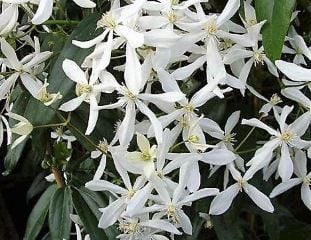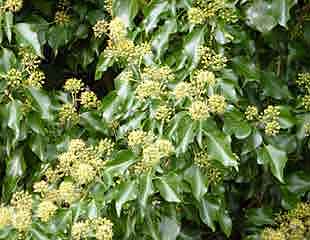
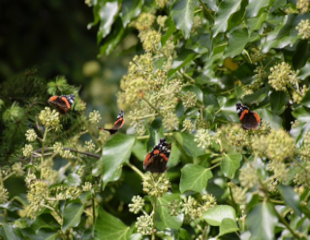
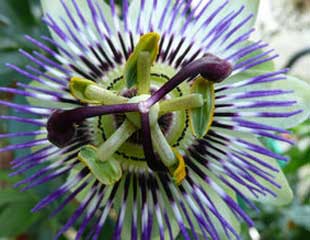
Easy to Grow Evergreen Climbing plants for Colour and Wildlife
Evergreen climbing plants add all year-round interest, colour and attract wildlife to your garden. They are ideal to scramble up pergolas, walls and fences to provide privacy. Many evergreen climbers are vigorous, garden speak for quick growing, ideal if you want to cover up something in the garden. Most evergreen climbers (except Clematis armandii) are tough, grow anywhere, sort of plants, which makes our gardening easier. Many evergreen climbing plants attract insects and produce berries which feed the birds.
Here are six easy-to-grow evergreen climbing plants
Clematis Armandii
Clematis armandii, illustrated here, is a lovely evergreen or semi-evergreen climber. it has glossy leaves and scented flowers in early spring, from February & March. However, to grow it, you need the right conditions; otherwise, it can look unsightly. The second image shows C.armandii growing in less than ideal conditions.
Because it is H4 hardy, it needs to be planted in a sheltered spot, such as near a wall and in full sun.
In the right spot, C. armandii will reward with masses of flowers and colour in late winter and early spring.
These flowers provide early nectar for emerging bees when there may be little else in flower. If you have good sheltered conditions, with well-drained soil with no winter wet, C. armandii is a winner and will quickly clothe a fence, growing up to 8m in 5+ years. There are several varieties of C. armandii, many are white, but there is also a lovely pale pink variety C. armandii 'apple blossom' (available from Crocus affiliate link)
Passiflora caerulea Blue Passion Flower

Passiflora, an evergreen or semi-evergreen climber with lovely flowers (shown top right), illustrated here growing around a door. Most commonly grown is the blue Passiflora caerulea, which is fully hardy. There is also a white variety, P.Constance Elliot which is also H4 hardy.
Being H4 hardy, it is best planted in a sheltered south/west-facing space near a wall or fence. It is vigorous and grows best, up to 12m, in full sun on a south/west-facing wall. In good conditions, it will also produce orange fruits after flowering. In colder areas, it tends to be semi-evergreen, shedding some leaves in the autumn with regrowth in spring. The flowers and their shape attract honey bees.
How to grow Passion Flower: care, planting, and pruning tips
Hedera helix English Ivy
This is our native Ivy and one of the most wildlife-friendly plants you can add to your garden. The images show how an immature and a mature plant. Unusually, Hedera changes form on reaching maturity at around 10 years; its leaf shape changes, and it produces fruits and flowers.
At this stage, not only is it attractive, but it is also a haven for wildlife. Hedera is top of the list for wildlife, sheltering invertebrates, and birds. The abundant late-season nectar in the flowers attracts pollinators, and birds consume the berries in the autumn. Many conservationist charities widely promote growing Ivy, as it is a top performer for wildlife, even though people formerly maligned it. Here is a link to an excellent article by the Woodland Trust.
Hedera is shade-tolerant and will grow in dry shade, which is such a tricky spot to fill in the garden, and it is hardy.
Trachelospermum jasminoides Star Jasmine
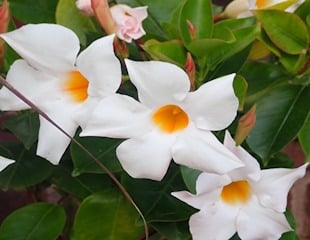
Also known as Star Jasmine, it has lovely glossy foliage with star-shaped scented flowers. This is one of the best evergreen garden climbing plants. Described as H4 hardy, it will benefit from being planted in a sunny, sheltered location away from cold winds. Well-drained soil is essential to prevent winter wetness. Information and growing tips about Star Jasmine, a lovely midsummer flowering climbing plant. Once established, it rewards well with very fragrant flowers, good foliage, which turns bronze in the winter.
Its scented flowers attract bees, butterflies, moths and other pollinators.
It is not particularly fast growing or vigorous, although over 10 years it can reach up to 12m.
Distinguish from Jasminum polyanthum, which is evergreen and scented, but only H2 hardy suitable for conservatories.
Buy from Suttons, where there is also a lovely pink variety, 'Star of Milan
Garrya elliptica Silk Tassel Bush

Garrya elliptica can be trained as a climber, being an evergreen shrub or small tree.
You can easily train Garrya elliptica to cover a wall as in the image. Its common name is silk tassel bush on account of the long tassels it produces over late autumn and winter.
Easy to grow in most soil types and sun or semishade, it is evergreen and H4 hardy. .Irrespective of the official hardy rating, I have seen Garrya elliptica growing really well in the Pennines (in a Co Op car park), which is a cold and wet area of the UK.
Garrya produces tassels right from an immature stage, which become more impressive with age. More images and growing about growing Garrya elliptica
Pyracantha Firethorn bush

Pyracantha is another shrub which you can train as a climber. Here it is, fan trained onto a wall. I have also seen it shaped around windows and front doors. In spring it has white flowers which are attractive to pollinators, followed, over autumn and early winter, by spectacular red, yellow or orange berries, depending on the variety.
Pyracantha is a tough grow anywhere shrub. It will grow in most soil types, sun and semi shade, and once established, is drought resistant. It is also fast growing, around 50 cm a year up to around 4m. It is easily contained and trained with pruning and is and very hardy H6 -20.
Both Crocus and Suttons have a good selection of several varieties of Pyracantha in a range of sizes.
Clematis 'Winter Beauty'

Clematis urophylla ' Winter Beauty has glossy foliage and nodding, bell-shaped white flowers from around December to February.
It is H3 hardy, so it needs a bit more tlc, a sheltered spot away from chilly winds. A south /west-facing wall will provide shelter and, by virtue of the rain shadow, help to keep the soil dry and avoid winter wet.
I took these images in December, in Rutland, where during the winter its very cold (but dry.) The clematis was growing well around a front door, suggesting that grown in the right conditions, it is more hardy. Flowering early in the year it provides nectar in the winter.
It is pruning group 1 and is one of the more compact Clematis reaching up to 4.
Crocus has 'Winter Beauty' for sale, including mature plants.


